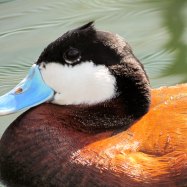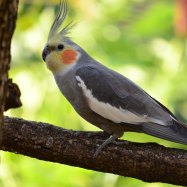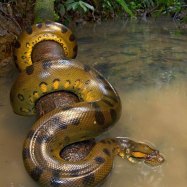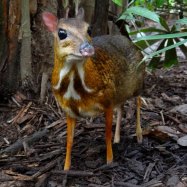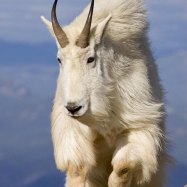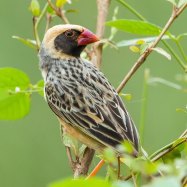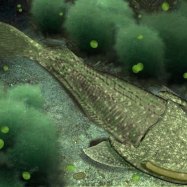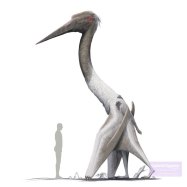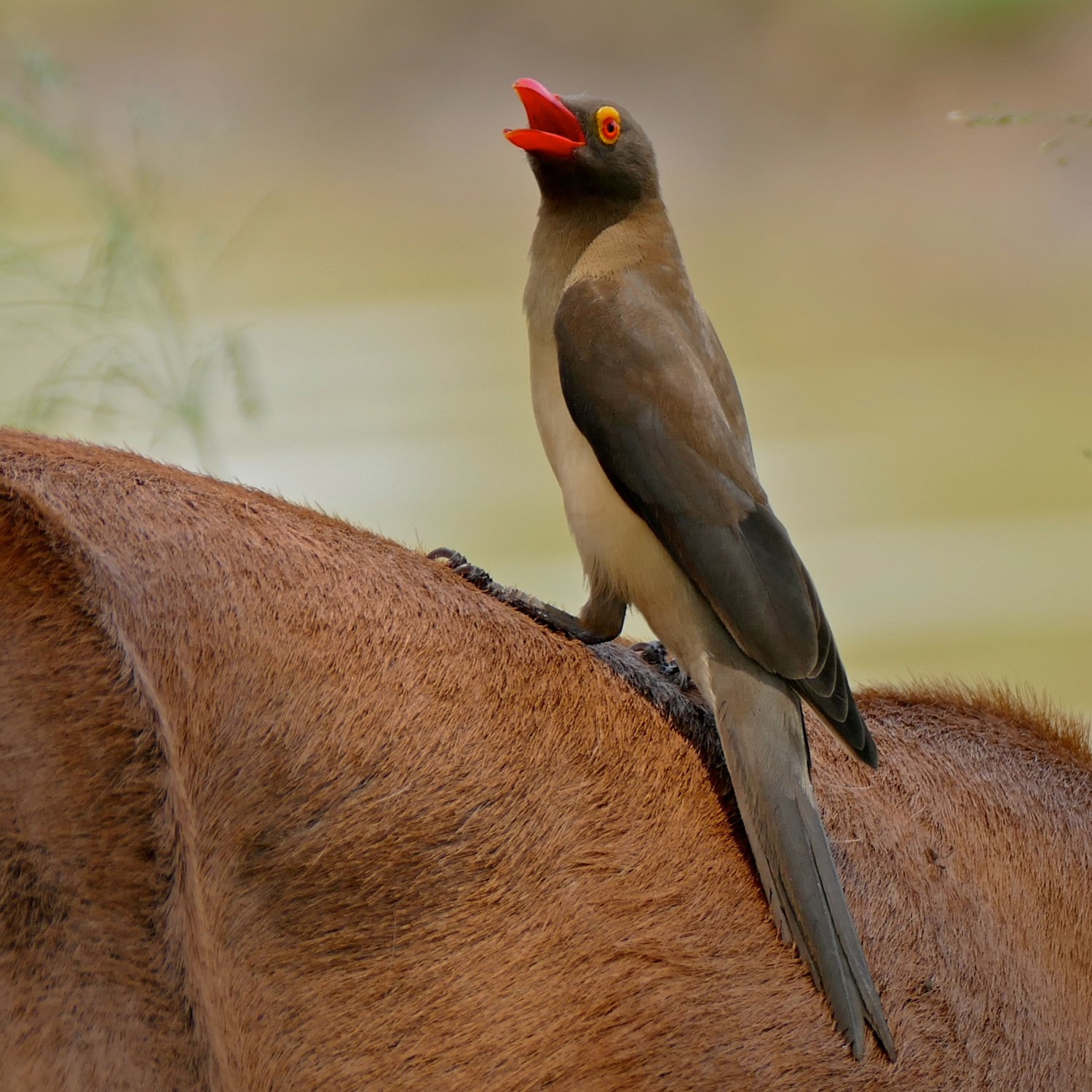
Oxpecker
20 - 22 cm
The Oxpecker, also known as the tickbird, is a small to medium-sized bird found in Southern and East Africa. With a compact body and measuring 20-22 cm in length, these birds are easily recognizable for their symbiotic relationship with large mammals. They often perch on the backs of animals such as giraffes and zebras, feeding on the ticks and parasites on their hosts. This helps keep the animals clean and healthy, making the Oxpecker an essential part of the ecosystem in this region.
Animal Details Summary:
Common Name: Oxpecker
Kingdom: Animalia
Habitat: Savannas, grasslands, and woodlands
The Fascinating Oxpecker: A Bird That Cares for Others in the African Savannas
The African savannas are home to some of the most majestic and fascinating animals in the world. From the towering elephants and graceful giraffes to the sleek big cats and powerful rhinos, these open grasslands are teeming with life. However, amidst all these magnificent creatures, there is one small bird that often goes unnoticed - the Oxpecker.Known scientifically as Buphagus africanus, the Oxpecker is a species of bird belonging to the Class Aves, and the order Passeriformes Oxpecker. It may not be as large or as eye-catching as some of its savanna companions, but it plays a crucial role in the ecosystem. In this article, we will delve deeper into the world of these little birds, and discover why they are such a unique and important species.
A Little Background on the Oxpecker
The Oxpecker, also commonly known as the Red-billed Oxpecker or the Yellow-billed Oxpecker, is a member of the Buphagidae family. It is found exclusively in Sub-Saharan Africa, in countries such as Kenya, Tanzania, Zimbabwe, and South Africa, to name a few. These birds are mostly found in the southern and eastern parts of the continent, where the habitat is suitable for their survival.One of the most distinctive features of the Oxpecker is its feeding method. These birds are classified as ectoparasites, meaning they feed on the external parasites found on larger animals. In fact, their scientific name 'Buphagus' means 'ox-eater' in Greek, and 'africanus' refers to their African origin. This unique feeding behavior has earned them the nickname 'the doctor bird' or 'the tickbird' among the locals Orinoco Crocodile.
A Home in the Savannas
As mentioned earlier, the Oxpecker is found in savannas across Sub-Saharan Africa. These vast and open grasslands provide the perfect habitat for these birds to thrive. They can also be found in grasslands and woodlands, as long as there are large mammals nearby.One might wonder why these birds are categorized as ectoparasites and not just regular parasites. The reason lies in their relationship with the larger mammals in the savannas. Oxpeckers and the animals they feed on have a unique symbiotic relationship, where both parties benefit. The birds get a meal, while the mammals get rid of annoying and potentially harmful parasites.
A Unique Feeding Behavior
The Oxpecker is a master at finding and feeding on various parasites that can be found on the skin of large mammals. These parasites include ticks, botfly larvae, and other insects. As the birds move across their host's skin, they use their sharp beaks to pick and remove any parasites they come across. This not only benefits the birds but also helps the mammals stay healthy and free from parasites.Another reason why these birds are considered ectoparasites is that they have been known to pick at scabs and open wounds on their host's skin. While this may seem like a harmful behavior, it actually helps the animals by removing dead tissue and promoting faster healing. It has been observed that when Oxpeckers are present, the wounds on animals heal more quickly compared to those without the birds.
A Distinctive Appearance
The Oxpecker may not be the most colorful or striking bird in the savannas, but it does have some unique physical characteristics. These birds have a brownish-gray plumage with a reddish-brown head and neck. They have a small and compact body, measuring around 20-22 cm in length and weighing between 40-60 grams.One of the most noticeable features of the Oxpecker is its powerful beak. It is long and curved, with a pointed tip, perfect for picking at tough parasites. Additionally, these birds have specially adapted zygodactyl feet, meaning their toes are arranged in a special pattern that helps them grip onto their host's skin better.
The Role of Oxpeckers in the Ecosystem
As mentioned earlier, Oxpeckers play a crucial role in the African savanna ecosystem. Apart from being a reliable source of food for the birds, their feeding behavior also benefits the larger mammals they feed on. By getting rid of parasites, they help keep these animals clean and healthy.Moreover, Oxpeckers have been found to act as protectors for their hosts. They have loud and distinctive alarm calls, which they use to alert the animals if they sense any approaching danger. This gives the mammals a chance to flee and protect themselves from predators.
The Future of the Oxpecker
Despite their importance in the ecosystem, the Oxpecker population has been on a decline in recent years. This is mainly due to habitat loss and human interference. As grasslands are converted into agricultural land, the birds lose their natural habitat and food sources. Furthermore, some humans view them as pests, and their eggs are sometimes collected for traditional medicine.To protect and preserve these unique birds, conservation efforts have been put in place. Many African countries have designated protected areas for the Oxpecker, and there are ongoing initiatives to educate locals about the birds' importance. It is crucial to raise awareness about their role in the ecosystem to ensure their survival and that of their host animals.
In Conclusion
In conclusion, the Oxpecker may be a small and unassuming bird, but it plays a significant role in the African savanna ecosystem. Its unique feeding behavior and symbiotic relationship with larger mammals make it a vital species for maintaining a healthy balance in these grasslands. The future of these birds may be uncertain, but with proper conservation efforts, we can ensure that they continue to thrive and contribute to the beauty and diversity of the African savannas. So next time you're on a safari or exploring the open grasslands, keep an eye out for these little birds and appreciate the crucial role they play in this magnificent ecosystem.

Oxpecker
Animal Details Oxpecker - Scientific Name: Buphagus africanus
- Category: Animals O
- Scientific Name: Buphagus africanus
- Common Name: Oxpecker
- Kingdom: Animalia
- Phylum: Chordata
- Class: Aves
- Order: Passeriformes
- Family: Buphagidae
- Habitat: Savannas, grasslands, and woodlands
- Feeding Method: Ectoparasite on large mammals
- Geographical Distribution: Sub-Saharan Africa
- Country of Origin: Multiple countries in Africa
- Location: Southern and East Africa
- Animal Coloration: Brownish-gray plumage
- Body Shape: Small to medium-sized bird with a compact body
- Length: 20 - 22 cm
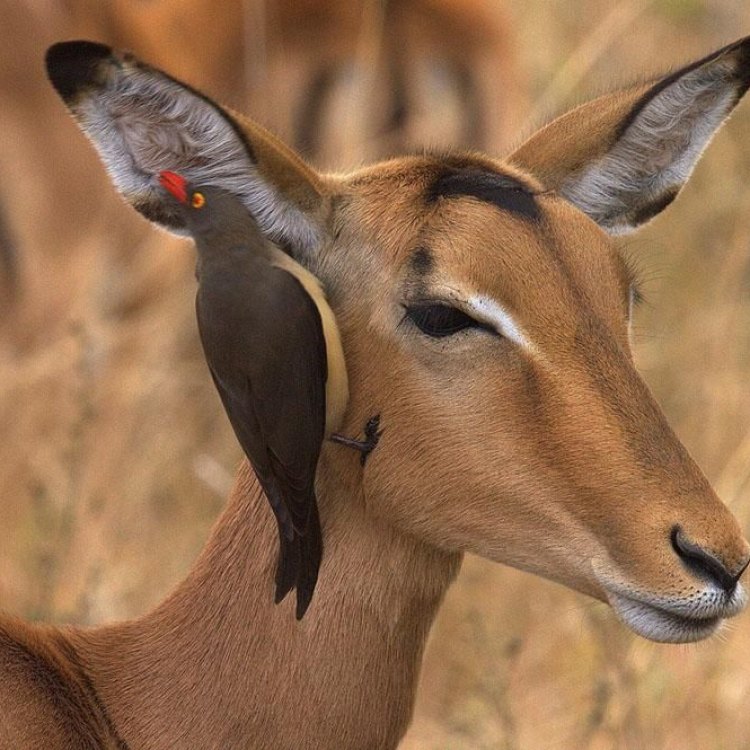
Oxpecker
- Adult Size: Small
- Average Lifespan: 8 - 10 years
- Reproduction: Breeding pairs
- Reproductive Behavior: Monogamous
- Sound or Call: Varied calls and chirps
- Migration Pattern: Some populations are migratory
- Social Groups: Live in small groups or pairs
- Behavior: Commensal relationship with large mammals
- Threats: Habitat loss and fragmentation
- Conservation Status: Least Concern
- Impact on Ecosystem: Control of ectoparasite populations
- Human Use: No direct human use
- Distinctive Features: BILL: Sharp, curved, and pointed bill for feeding on ectoparasites
- Interesting Facts: Oxpeckers are often found on the backs of large mammals, feeding on ticks and other parasites. They have a symbiotic relationship with these animals, where the oxpeckers benefit from the food source, and the mammals benefit from parasite removal.
- Predator: Snakes, birds of prey, and small carnivores
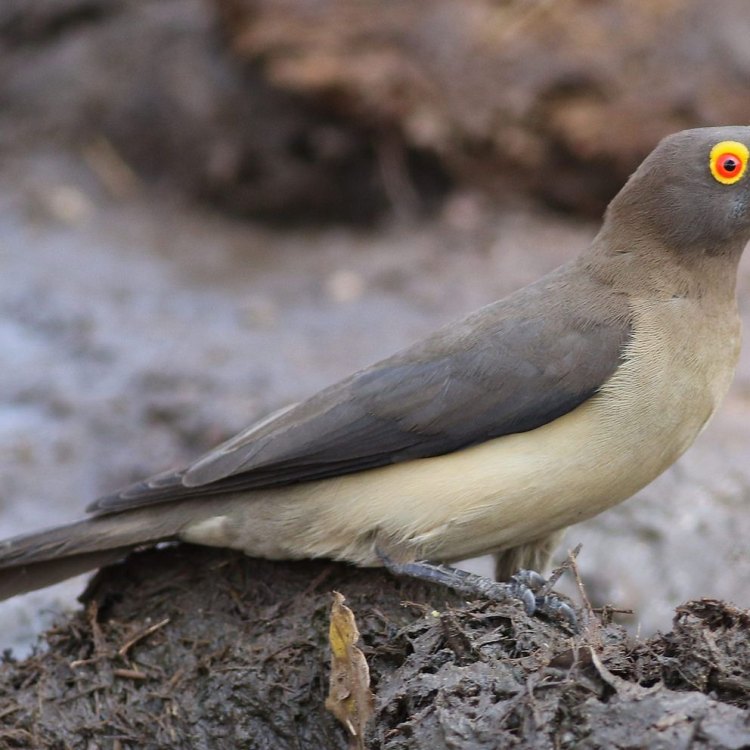
Buphagus africanus
The Fascinating World of Oxpeckers: Nature's Pest Controllers
When you think of birds, the first image that may come to mind is a chirpy, colorful creature perched on a branch or flying in the sky. But in the savannas and woodlands of Africa, you will often find a small, unassuming bird with a unique and vital role to play in the ecosystem – the oxpecker.With its distinct sharp beak and unique symbiotic relationship with large mammals, the oxpecker is a fascinating bird to study and a crucial player in maintaining the balance of its habitat. Let's take a closer look at these small birds and uncover the many interesting features that make them stand out in the avian world PeaceOfAnimals.Com.
The Basics: Size, Lifespan, and Reproduction
Oxpeckers belong to the family Buphagidae and are divided into two species - the red-billed oxpecker and the yellow-billed oxpecker. They are small birds, measuring only about 20cm in length and weighing around 50 grams. They have a wingspan of approximately 30cm, and their feathers are colored in various shades of brown and grey, with patches of red and yellow on their bills.These birds have a relatively short lifespan, with an average of 8-10 years in the wild. However, some oxpeckers have been known to live for up to 15 years in captivity.
Oxpeckers are monogamous, with breeding pairs staying together for their whole lifespan. They nest in tree cavities and lay a clutch of 2-3 eggs, which both parents take turns incubating. The chicks hatch after about two weeks and are fed insects and other small invertebrates by their parents until they are ready to leave the nest after 3-4 weeks.
The Sounds of Oxpeckers
One of the most distinctive features of oxpeckers is their varied repertoire of calls and chirps Ori Pei. These birds use different vocalizations to communicate amongst themselves and with other species.Their calls include a soft, melodious twitter when relaxed, a harsh and repetitive call when alarmed, and a loud, screeching call when in distress. These calls can often be heard in a chorus when a group of oxpeckers is flying or perching together.
Commensal Relationship with Large Mammals
One of the most fascinating behaviors of oxpeckers is their commensal relationship with large mammals. These birds are often seen perched on the backs of animals such as zebras, antelopes, and giraffes, feeding on ticks and other parasites found on their hosts' skin.This relationship is beneficial to both parties involved. The oxpeckers have a reliable source of food, while the animals benefit from the removal of potentially harmful parasites that can cause skin irritation, anemia, and even disease.
Threats and Conservation Status
Despite their crucial role in maintaining the health of their habitat, oxpeckers are facing threats due to habitat loss and fragmentation. As savannas and woodlands are cleared for human development and agriculture, oxpeckers lose their nesting sites and food sources, leading to a decline in their population.However, these birds have a widespread distribution, and their numbers are stable overall. Therefore, they are currently classified as a species of Least Concern on the IUCN Red List.
The Impact of Oxpeckers on the Ecosystem
The role of oxpeckers in controlling ectoparasite populations cannot be overstated. These birds are natural pest controllers, helping to keep the ectoparasite population under control. This, in turn, benefits not only large mammals but also the entire ecosystem.By feeding on parasites, oxpeckers help to prevent the spread of diseases and improve the overall health of the animals they live with. Additionally, by removing ticks and other parasites, oxpeckers also indirectly benefit the plants in their habitat, as these pests can transmit diseases to vegetation as well.
The Unique Bill of Oxpeckers
One of the most distinctive physical features of oxpeckers is their sharp, curved, and pointed bill. This beak is perfectly adapted for their specialized diet of feeding on ectoparasites.Oxpeckers use their beak to probe into the skin of their host animals, searching for ticks, lice, and other insects to feast on. Their sharp beak enables them to remove any parasites they come across effectively, while the curved shape allows them to access parasites in hard-to-reach areas.
Interesting Facts about Oxpeckers
- Oxpeckers are known by many different names, including tickbirds, oxpecking birds, and buffalo birds.- A group of oxpeckers is called a "parliament" or a "rush."
- These birds have a unique habit of roosting together in tight, communal clusters at night, often with their beaks tucked under their wings.
- Aside from feeding on parasites, oxpeckers also consume blood and tissue from open wounds on the animals they live with.
- Some populations of oxpeckers are migratory, while others are sedentary, depending on the availability of food sources in their habitat.
Natural Predators of Oxpeckers
Despite their beneficial relationships with large mammals, oxpeckers are not completely safe in their habitats. These birds have natural predators, including snakes, birds of prey, and small carnivores such as mongoose and genets.However, their population is not threatened by these predators, as their ability to fly and roost in groups allows them to stay vigilant and evade attacks.
No Direct Human Use
Oxpeckers have no direct human use, and there is no record of any cultural or historical significance attached to them. However, their presence in nature provides a valuable lesson on the importance of maintaining a balanced ecosystem and respecting the roles of all living beings.In conclusion, oxpeckers may be small and unassuming, but they play a vital role in maintaining the health and balance of their habitat. With their unique features and behaviors, they are an essential part of the intricate web of life in African savannas and woodlands, and their conservation is crucial for the wellbeing of other species and the ecosystem as a whole.
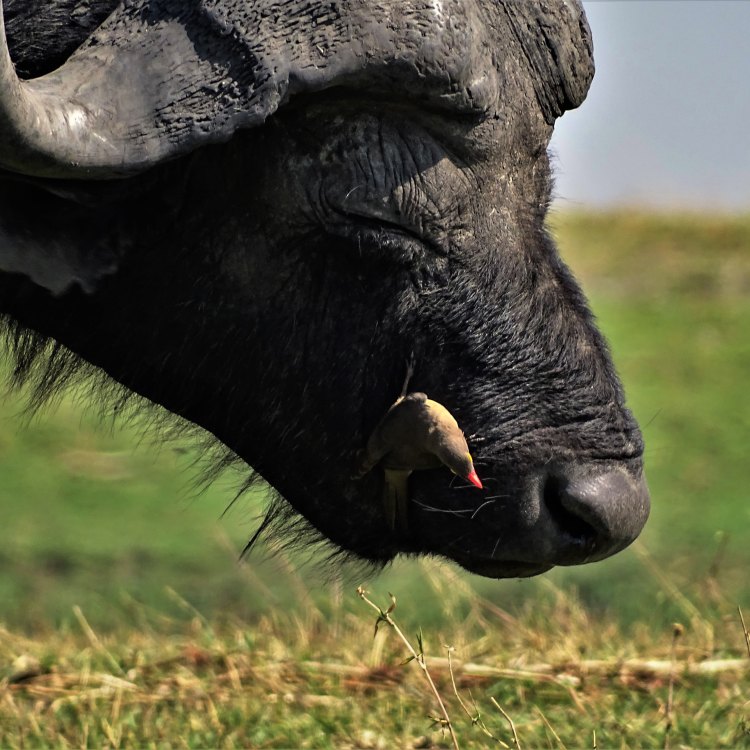
The Fascinating Oxpecker: A Bird That Cares for Others in the African Savannas
Disclaimer: The content provided is for informational purposes only. We cannot guarantee the accuracy of the information on this page 100%. All information provided here may change without prior notice.

